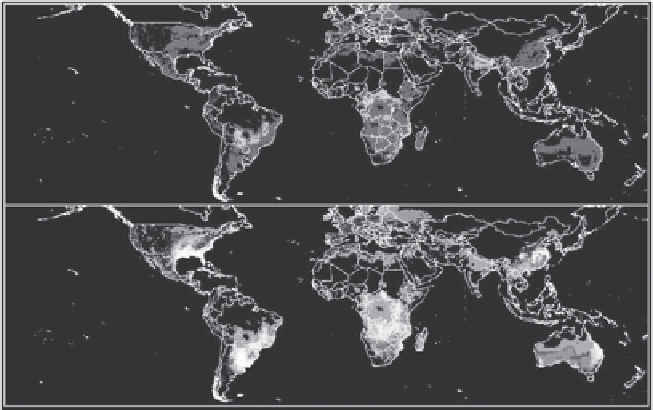Environmental Engineering Reference
In-Depth Information
where to look, further spread of this species should be containable because trees
can be physically removed, and the spread of seeds (in stock feces) can be prevented
as long as animals are not moved indiscriminately. Part of the management response
will be to raise public awareness of the weed and how to control it.
The Argentine ant (
Linepithema humile
), a native of South America, is now estab-
lished on every continent except Antarctica. It can achieve extremely high densities
and has unpleasant consequences for biodiversity (eliminating native ants and other
invertebrates) and for domestic life, with its nasty tendency to swarm over human
foodstuffs and even sleeping babies. A niche model was developed for the ant, based
on occurrences in its native and invaded ranges and related both to climatic data
(e.g. m a x imum, minimum and mean temperatures, precipitation, number of frost
days, number of wet days) and topographic data (e.g. elevation, slope and aspect).
The niche model provided a good fi t with current distribution based on current
climate. Next, several different climate change scenarios were modeled to produce
a range of predictions of the ant's future distribution. Figure 11.6 (see also color
plate 11.6) shows the average outcome of the models, indicating in red those areas
predicted to improve for the ant by 2050 (increased likelihood of ant occurrence)
and in blue those areas expected to worsen. The species will retract its range in
tropical areas but expand into higher latitudes. Ironically, the Argentine ant looks
set to do less well in its native South America than in North America and Europe.
Efforts to eradicate Argentine ants have rarely been successful. The management
response is therefore to increase vigilance and biosecurity precautions in regions
expected to become progressively more invadable as climate change takes hold.
11.2.3
Life-history
traits and the fate of
species - for better
or for worse
You lear nt in Chapter 3 how
r
-selected species (with a combination of traits that
allow them to multiply rapidly and produce large numbers of progeny) are often
good invaders, while
K
-selected species (with life histories that enable them to
Fig. 11.6
Predicted
changes to distribution of
the Argentine ant between
now and 2050. The map
represents the average
predictions of four global
climate change scenarios.
Red areas are those
predicted to improve for
Argentine ants, whereas
blue areas are predicted to
worsen for the species.
(After Roura-Pascual et al.,
2004.) (This fi gure also
reproduced as color plate
11.6.)
(a)
(b)






Search WWH ::

Custom Search